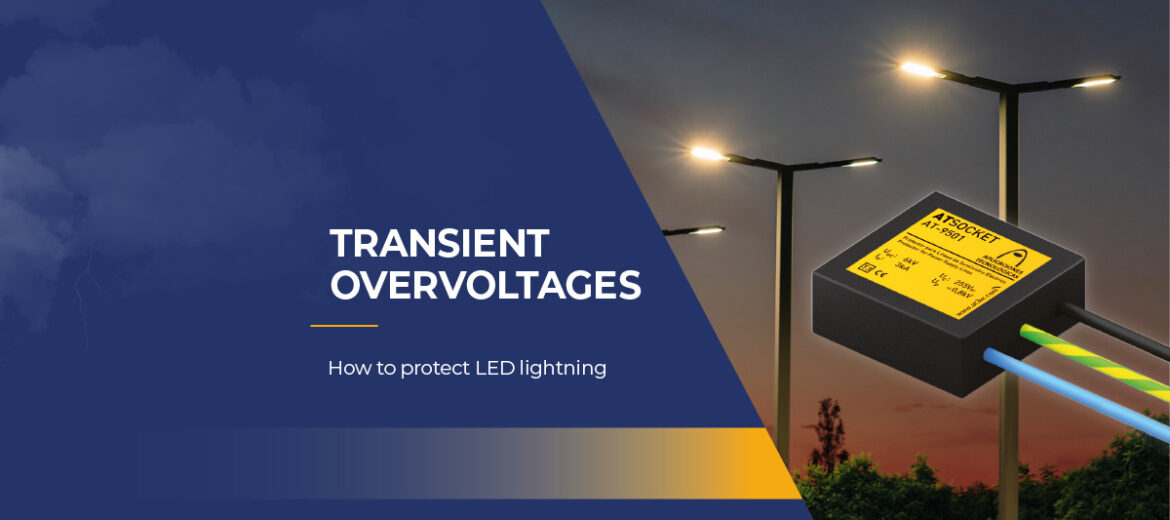The use of LED lighting has become an increasingly popular option for public and private urban lighting, due to its numerous advantages over traditional lighting. In some countries, it is even mandatory according to legislation. Long-term energy savings are behind this trend, but given its initial cost, it is imperative for LED lighting to be protected against transient overvoltages to ensure its correct operation.
Energy savings are crucial for the sustainability of the planet for several reasons. Firstly, most of the energy sources currently used, such as fossil fuels, are finite and their excessive use contributes to climate change and pollution. In addition, the production and distribution of energy require a large number of natural resources and can have negative impacts on the environment. By reducing our energy consumption through practices such as energy efficiency and the use of renewable energy, we can lower our carbon footprint and reduce long-term environmental damage. Last but not least, energy savings also mean financial savings over time.
Light-emitting diode (LED) lamps are more efficient than incandescent and CFL bulbs and have a longer lifetime, while providing similar brightness. LED lamps are more convenient than conventional bulbs and also make progress in terms of environmental friendliness, but from an economic point of view, LEDs have higher initial costs.1 That is why they must be suitably protected against transient overvoltages.
LED lighting: advantages of street lighting with LED technology vs. conventional lighting
The main differences between traditional street lighting and LED lighting include:
- Energy efficiency: LED lighting is more energy efficient than traditional lighting. LEDs use less energy to produce the same amount of light as traditional lights. LEDs can save up to 50% of energy compared to traditional lights.
- Lifespan: The lifespan of LEDs is much longer than traditional lights. While traditional light can last around 1,000 hours, LEDs can last up to 50,000 hours. This means that LED lights have a much longer lifespan, which reduces replacement and maintenance costs.
- Light quality: LED lighting emits a brighter and sharper light than traditional lighting. In addition, LED light can be of different colours and shades, allowing for greater customisation in urban lighting design.
- Lighting control: LED lights are easier to control than traditional lights. They can be dimmed or controlled to change the intensity or colour of the light, allowing for greater energy savings.
- Less light pollution: LED lighting is more efficient in terms of its direction of light and minimises unwanted light scattering. This can help reduce light pollution and allow better visibility of the night sky.
In some countries, new street lighting installations are required by law to use LED luminaires. One of the latest countries to join has been Spain, through Royal Decree-Law 18/2022, of 18 October, which establishes that from 1 January 2023, all public lighting projects must be carried out using LEDs which “in turn, significantly improve the minimum energy efficiency requirements (Ԑ), improving by an average of 119% for functional lighting and 163% for ambient lighting, as well as demanding a new maximum unit power (Pu) requirement, which limits the power to be installed per surface area”. 2 Other countries, such as the UK, have set a target of 70% of their road lighting to be LED by 2027.
Transient overvoltage protection for LED lighting
Surges are sudden, short-lived surges in the voltage of a power supply that have adverse effects on its components. Although not dangerous when they occur normally, these surges (transient overvoltages) can be detrimental to LED lights due to their extremely fast switching times and low resistance. Here’s why LED street lighting needs transient overvoltage suppression protection.
Here are the main risks:
- Component damage: Transient overvoltages can damage the electronic components of LED lighting equipment, which can lead to decreased equipment life and increased maintenance costs.
- Loss of light quality: Transient overvoltages can cause fluctuations in the current supplying the LEDs, which can cause flickering or changes in light intensity, which can lead to eyestrain in those exposed to it.
- Fire Hazard: Transient overvoltages can generate sparks or arcing which if in contact with flammable materials, can cause fires.
- Service interruption: Transient overvoltages can cause power interruption, which can lead to significant economic losses in some sectors.
Protection against transient overvoltages: AT SOCKET
The ATSOCKET protectors developed by Aplicaciones Tecnológicas S.A. are installed inside the luminaires or as close as possible to the equipment to be protected and are capable of withstanding secondary lightning currents of thousands of amperes, leaving residual voltages below 1.5kV.
The ATSOCKET 5kA, specifically, is specially designed to protect outdoor lighting equipment and public lighting, safeguarding this equipment and thus improving safety on streets and roads, avoiding blackouts and traffic disruptions that could even cause accidents.
With a size similar to a wristwatch, ATSOCKET transient overvoltage protectors can be installed inside a conduit, very close to the equipment to be protected even if they are located outdoors such as luminaires or traffic lights.
If you want to know more about how to protect against transient overvoltages, you can contact us through this link.
You can also attend any of our webinars on surge protection via our webinars page.
References
- ScientificWorldJournal. Cost-Benefit Analysis and Emission Reduction of Energy-Efficient Lighting at the Universiti Tenaga Nasional (2014)
- Boletín Oficial de Estado (BOE). núm. 251, de 19/10/2022.



